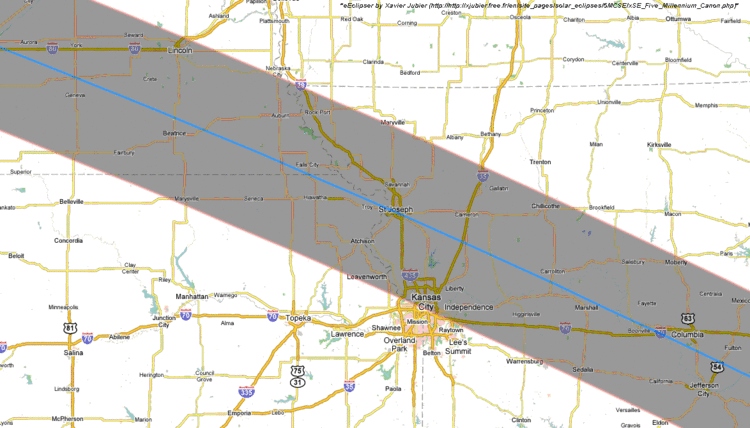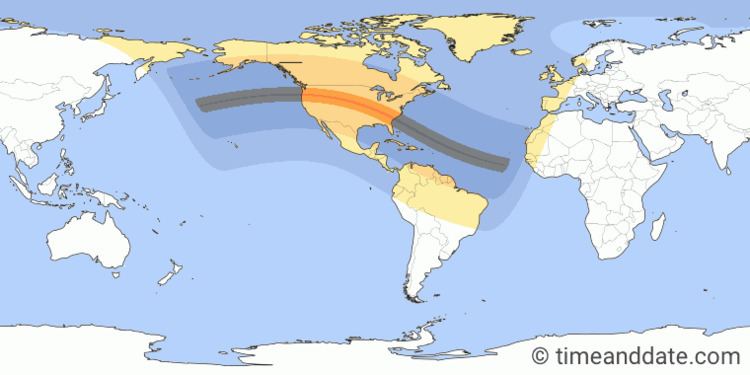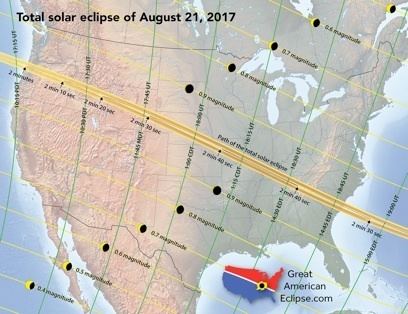Nature Total Magnitude 1.0306 Max. width of band 115 km (71 mi) Date 21 August 2017 | Gamma 0.4367 Duration 160 sec (2 m 40 s) (P1) Partial begin 15:46:48 | |
 | ||
Other Instances Solar eclipse of April 8 - 2, Solar eclipse of July 2 - 20, Solar eclipse of March 9, Solar eclipse of March 20, Solar eclipse of April 29 | ||
Solar eclipse of august 21 2017
A total solar eclipse will take place on Monday, August 21, 2017. A solar eclipse occurs when the Moon passes between Earth and the Sun, thereby totally or partly obscuring the image of the Sun for a viewer on Earth.
Contents
- Solar eclipse of august 21 2017
- Visibility
- Related eclipses over the United States
- Eclipse viewing events
- The eclipse in Europe
- Related eclipses
- Solar eclipses 20152018
- Saros series 145
- Metonic series
- References

A total solar eclipse occurs when the Moon's apparent diameter is larger than the Sun's, blocking all direct sunlight, turning day into darkness. Totality occurs in a narrow path across Earth's surface, with the partial solar eclipse visible over a surrounding region thousands of kilometers wide.

This eclipse is the 22nd of the 77 members of Saros series 145, the one that also produced the solar eclipse of August 11, 1999. Members of this series are increasing in duration. The longest eclipse in this series will occur on June 25, 2522 and last for 7 minutes and 12 seconds.

Visibility
The eclipse will have a magnitude of 1.0306 and will be visible from a narrow corridor through the United States. The longest duration of totality will be 2 minutes 41.6 seconds at 37°35′0″N 89°7′0″W in Shawnee National Forest just south of Carbondale, Illinois and the greatest extent will be at 36°58′0″N 87°40′18″W near Cerulean, Kentucky between Hopkinsville and Princeton, Kentucky. It will be the first total solar eclipse visible from the southeastern United States since the solar eclipse of March 7, 1970.

A partial solar eclipse will be seen from the much broader path of the Moon's penumbra, including all of North America, northern South America, western Europe, and Africa.
Related eclipses over the United States
This eclipse will be the first total solar eclipse visible from the United States since the solar eclipse of July 11, 1991 (which was seen only from part of Hawaii), and the first visible from the contiguous United States since 1979.
The path of totality of the solar eclipse of February 26, 1979 passed only through the states of Washington, Oregon, Idaho, Montana, and North Dakota. Many visitors traveled to the Pacific Northwest to view the eclipse, since it was the last chance to view a total solar eclipse in the contiguous United States for almost four decades.
Some American scientists and interested amateurs seeking to experience a total eclipse participated in a four-day Atlantic Ocean cruise to view the solar eclipse of July 10, 1972 as it passed near Nova Scotia. Organizers of the cruise advertised in astronomical journals and in planetarium announcements emphasizing the lack of future U.S. total eclipses until this 2017 event.
The August 2017 eclipse will be the first with a path of totality crossing the USA's Pacific coast and Atlantic coast since 1918. Also, its path of totality makes landfall exclusively within the United States, making it the first such eclipse since the country's independence in 1776. (The path of totality of the eclipse of June 13, 1257, was the last to make landfall exclusively on lands currently part of the USA.)
The path of this eclipse crosses the path of the upcoming total solar eclipse of April 8, 2024, with the intersection of the two paths being in southern Illinois in Makanda Township at Cedar Lake just south of Carbondale. A small land area, including the cities of Makanda, Carbondale, Cape Girardeau, Missouri, and Paducah, Kentucky, will thus experience two total solar eclipses within a span of fewer than seven years.
The solar eclipse of August 12, 2045 will have a very similar path of totality over the USA, about 400 km (250 mi) to the southwest, also crossing the USA's Pacific coast and Atlantic coast; however, duration of totality will last over twice as long.
An eclipse of comparable length (up to 3 minutes 8 seconds) occurred over the contiguous United States on March 7, 1970 along the southeast US coast, from Florida to Virginia.
Eclipse viewing events
An international consortium of festivals led by Symbiosis Gathering will be hosting a Global Eclipse Gathering near Prineville, Oregon on August 17–23, 2017. Dubbed Oregon Eclipse, the event will feature several stages of music, workshops, and art. Symbiosis previously was involved in the production Pyramid Eclipse, an annular eclipse on the land of the Pyramid Lake Paiute Tribe outside of Reno, Nevada as well as Eclipse 2012, a total solar eclipse event outside of Cairns, Australia. Global Eclipse Gatherings have been gaining momentum over the last few decades.
The eclipse in Europe
In northwestern Europe, the eclipse will only be visible as a partial eclipse, in the evening or at sunset. Only Iceland, Scotland and Ireland will see the eclipse from beginning to end, in the rest of the UK, Norway, the Netherlands, Belgium, France, Spain and Portugal sunset will occur before the end of the eclipse. In Germany, only in the extreme northwest the beginning of the eclipse might be visible just at sunset. In all regions east of the orange line in the map the eclipse will be invisible.
Related eclipses
A partial lunar eclipse will take place on August 7, 2017.
Solar eclipses 2015–2018
Each member in a semester series of solar eclipses repeats approximately every 177 days and 4 hours (a semester) at alternating nodes of the Moon's orbit.
Saros series 145
This solar eclipse is a part of Saros cycle 145, repeating every 18 years, 11 days, containing 77 events. The series started with partial solar eclipse on January 4, 1639, and reached a first annular eclipse on June 6, 1891. It was a hybrid event on June 17, 1909, and total eclipses from June 29, 1927 through September 9, 2648. The series ends at member 77 as a partial eclipse on April 17, 3009. The longest eclipse will occur on June 25, 2522, with a maximum duration of totality of 7 minutes, 12 seconds.
Metonic series
The metonic series repeats eclipses every 19 years (6939.69 days), lasting about 5 cycles. Eclipses occur in nearly the same calendar date. In addition the octon subseries repeats 1/5 of that or every 3.8 years (1387.94 days).
